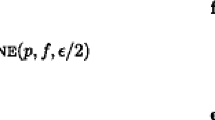Abstract
LetE be a finite set, ℱ be a family of subsets ofE and¯C be a capacity vector for all elements ofE. For eachF∈ℱ, define thecapacity ofF as the minimum capacity occurring inF. The problem which we discuss in this paper is how to change the vector¯C as little as possible so that a givenF 0∈8o has the maximum capacity. This model contains inverse maximum capacity spanning tree problem, inverse maximum capacity path problem and etc. as its special cases. We transform the problem into the minimum weight cut set problem and show that this problem can be solved efficiently if an efficient algorithm for finding minimum weight cut set of ℱ is available.
Zusammenfassung
Sei ℱ eine Familie von Teilmengen einer endlichen MengeE und¯C ein Kapazitätsvektor bzgl. der Elemente vonE. Für jedesF∈ℱ sei dieKapazität vonF als die minimale inF auftretende Kapazität definiert. Das in dieser Arbeit untersuchte Problem besteht darin, den Vektor¯C so wenig wie möglich abzuändern, sodass ein vorgegebenesF 0∈ℱ maximale Kapazität besitzt. Dieses Modell enthält die inversen Probleme maximaler Kapazität bei aufspannenden Bäumen, Pfaden usw. als Spezialfälle.
Wir transformieren das Problem in ein gewichtetes Schnittmengenproblem und zeigen, dass das Problem effizient lösbar ist, wenn ein effizienter Algorithmus zur Bestimmung einer minimalen Schnittmenge bzgl. ℱ zur Verfügung steht.
Similar content being viewed by others
References
Burton D, Toint PL (1992) On an instance of the inverse shortest paths problem. Mathematical Programming 53: 45–61
Zhang J, Ma Z, Yang C (1995) A column generation method for inverse shortest path problem. Zeitschrift für Operations Research 41: 347–358
Xu S, Zhang J (1995) An inverse problem of the weighted shortest path problem. Japan Journal of Industrial and Applied Mathematics 12: 47–60
Zhang J, Liu Z, Ma Z (1996) On the inverse problem of minimum spanning tree with partition constraints. Zeitschrift für Operations Research 44: 171–187
Zhang J, Ma Z (1996) A network flow method for solving some inverse combinatorial optimization problems. Optimization 37: 59–72
Zhang J, Xu S, Ma Z (1998) An algorithm for inverse minimum spanning tree problem. Optimization Methods and Software (to appear)
Sokkalingam PT, Ahuja RK, Orlin JB (1996) Inverse spanning tree problem: formulations and algorithm. WP. 3890-96, MIT, Sloan School of Management, Massachusetts, USA
Nagamochi H, Ibaraki T (1992) Computing edge-connectivity in multigraphs and capacitated graphs. SIAM J Discrete Math 5: 54–66
Hao J, Orlin JB (1994) A faster algorithm for finding the minimum cut in a directed graph. J Algorithms 17: 424–446
Stoer M, Wagner F (1994) A simple min cut problem. In: Proceedings of the 2nd European Symposium on Algorithms. Springer, Berlin Heidelberg New York
Ahuja RK, Magnanti TL, Orlin JB (1993) Network flows. Prentice-Hall, Englewood Cliffs
Oxley JG (1992) Matroid Theory. Oxford University Press, Oxford
Author information
Authors and Affiliations
Additional information
The authors gratefully acknowledge the partial support of the Hong Kong Research Grant Council (CityU Grant # 9040189)
Rights and permissions
About this article
Cite this article
Yang, C., Zhang, J. Inverse maximum capacity problems. OR Spektrum 20, 97–100 (1998). https://doi.org/10.1007/BF01539860
Received:
Accepted:
Issue Date:
DOI: https://doi.org/10.1007/BF01539860
Key words
- Inverse problems
- minimum weight cut set
- maximum capacity tree
- maximum capacity path
- minimum unrestricted cut




